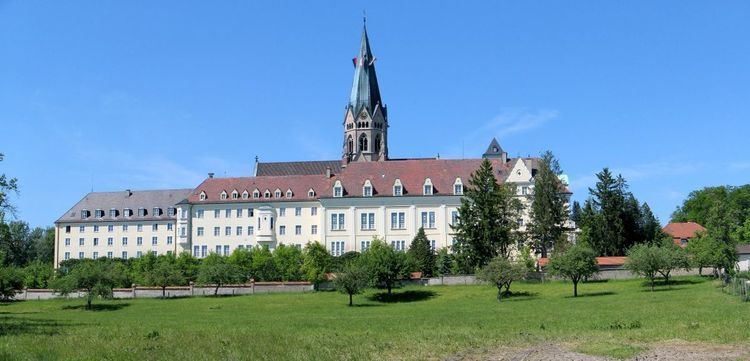Phone +49 8193 710 | ||
 | ||
Similar Missionsmuseum in Sankt Ottilien, Ammersee, Roman Catholic Diocese, Beuron Archabbey, Andechs Abbey | ||
St. Ottilien Archabbey (St. Ottilia's Archabbey) is a Benedictine monastery in Emming near Eresing and the Ammersee in the district of Landsberg, Oberbayern, Germany. It is the mother house of the St. Ottilien Congregation, otherwise known as the Missionary Benedictines.
Contents
Foundation
In the 16th century a small castle was built at Emming, including a chapel dedicated to Saint Ottilia. Both castle and chapel were made over in the Baroque style in the 17th century.
After several changes of owner, and the demolition of much of the castle in 1884, the estate came in 1886 into the possession of Andreas Amrhein, formerly a Benedictine from Beuron Archabbey. His vision of combining the Benedictine way of life with engagement in the Christian mission field had proved impossible to realise within the Beuron Congregation, and for that reason he sought to found a new and independent group. After an initial foundation in Reichenbach am Regen in the district of Cham in 1884 the community moved to Emming in 1887, where the monastery took its name from the already existing chapel of Saint Ottilia. In 1886/1887 the adjunct Rhabanus-Maurus-Gymnasium St. Ottilien was founded as a school for young Benedictian monks and the first group of missionaries were sent to Africa the same year.
Development
In 1895 Andreas Amrhein resigned from the community, which then became a priory. In 1902 St. Ottilien was elevated to the status of an abbey. After the foundation of another three abbeys St. Ottilien was chosen in 1914 as the archabbey of the St. Ottilien Congregation of the Benedictine Confederation, also known as the Missionary Benedictines. The Archabbot of St. Ottilien has ever since been ex officio the head of the St. Ottilien Congregation.
The abbey grew rapidly until 1930, developing mission fields in South Africa, Korea and China. St. Ottilien was extended during this period in order to accommodate the expanding community, which grew to almost 400 people.
In 1941 the abbey was suppressed by the Gestapo. The monks returned in 1945. Until 1948 former concentration camp prisoners were looked after in the abbey.
The abbey continued to sponsor the Rhabanus-Maurus-Gymnasium St. Ottilien until 1973, when this task was handed over to the Diocese of Augsburg. Until today, both institutions keep a close tie as a part of the administration and teaching staff of the school is held by Benedictian monks.
Buildings
The abbey church, dedicated to the Sacred Heart, was built between 1897 and 1899. Its pointed octagonal spire, 75 metres high, can be seen from a great distance around. The belfry contains a peal of eight bells which is one of the deepest in tone in southern Germany [1].
The three-aisled Neo-Gothic abbey church was consecrated in 1903. The mission museum, in the Art Nouveau sacristy to the south of the church, was opened in 1911.
Over the years St. Ottilien has added many new facilities: a school (the Rhabanus Maurus Gymnasium), retreat- and guest-houses, a publishing house, workshops and buildings for farming and horticulture.
